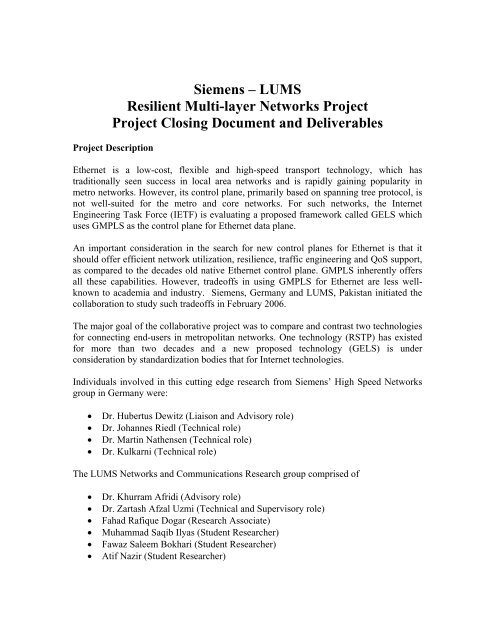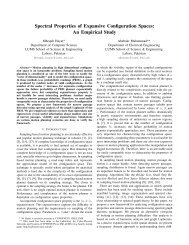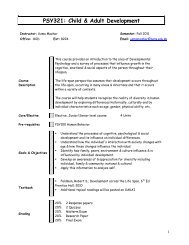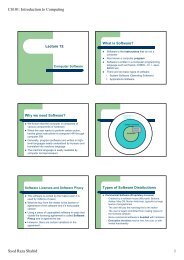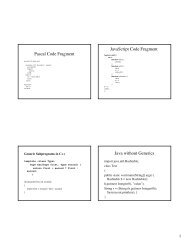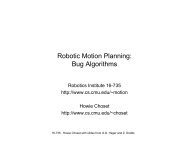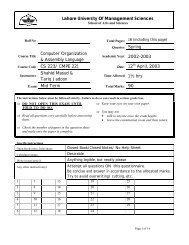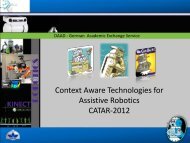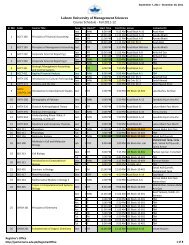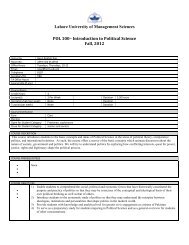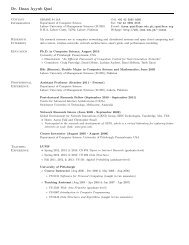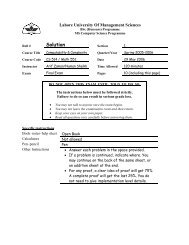You also want an ePaper? Increase the reach of your titles
YUMPU automatically turns print PDFs into web optimized ePapers that Google loves.
Siemens – <strong>LUMS</strong>Resilient Multi-layer Networks ProjectProject Closing Document and DeliverablesProject DescriptionEthernet is a low-cost, flexible and high-speed transport technology, which hastraditionally seen success in local area networks and is rapidly gaining popularity inmetro networks. However, its control plane, primarily based on spanning tree protocol, isnot well-suited for the metro and core networks. For such networks, the InternetEngineering Task Force (IETF) is evaluating a proposed framework called GELS whichuses GMPLS as the control plane for Ethernet data plane.An important consideration in the search for new control planes for Ethernet is that itshould offer efficient network utilization, resilience, traffic engineering and QoS support,as compared to the decades old native Ethernet control plane. GMPLS inherently offersall these capabilities. However, tradeoffs in using GMPLS for Ethernet are less wellknownto academia and industry. Siemens, Germany and <strong>LUMS</strong>, Pakistan initiated thecollaboration to study such tradeoffs in February 2006.The major goal of the collaborative project was to compare and contrast two technologiesfor connecting end-users in metropolitan networks. One technology (RSTP) has existedfor more than two decades and a new proposed technology (GELS) is underconsideration by standardization bodies that for Internet technologies.Individuals involved in this cutting edge research from Siemens’ High Speed Networksgroup in Germany were:• Dr. Hubertus Dewitz (Liaison and Advisory role)• Dr. Johannes Riedl (Technical role)• Dr. Martin Nathensen (Technical role)• Dr. Kulkarni (Technical role)The <strong>LUMS</strong> Networks and Communications Research group comprised of• Dr. Khurram Afridi (Advisory role)• Dr. Zartash Afzal Uzmi (Technical and Supervisory role)• Fahad Rafique Dogar (Research Associate)• Muhammad Saqib Ilyas (Student Researcher)• Fawaz Saleem Bokhari (Student Researcher)• Atif Nazir (Student Researcher)
The group from <strong>LUMS</strong> conducted extensive simulation experiments to evaluate GMPLSas a control plane for metro and core networks consisting of point-to-point Ethernet linksand compared it with that of native Ethernet control plane under both normal and singleelement failure scenarios. The <strong>LUMS</strong> team delivered a series of PowerPoint presentationsto Siemens group in two phases. These presentations summarized progressive researchresults which were discussed in detailed teleconferences with a focus on current researchdirection and future aspects of Siemens-<strong>LUMS</strong> project.Simulation Testbed and Tools (Developed and Used during the collaboration)• STP Simulator developed using C language by the team at <strong>LUMS</strong> for computingthe RSTP/STP tree in a bridged topology• C program developed by <strong>LUMS</strong> team to repeatedly run RSTP simulations undervarious failure scenarios using the open source bridgesim simulator• Unix shell scripts developed to compute convergence time from RSTP simulationresults reported in bridgesim trace files• C program developed to generate random traffic matrices for simulationsperformed on COST239 and COST266 network topologies. This program has theflexibility to generate either partial meshed or fully meshed network topologies.• TOTEM (Toolbox for Traffic Engineering Methods) simulator was used to carryout simulation results• A modification to CSPF algorithm, Compromised CSPF was developed in Javaand integrated with TOTEM• Java code to convert from TOTEM XML topology into STP simulator compatibletopology files was developed• Java code to import STP simulator’s output active topology into TOTEM wasdeveloped• Java hooks for TOTEM and STP simulator interoperation were developedDevelopment Methodology• Modified version of CSPF (Constrained Shortest Path First) algorithm calledCompromised CSPF was used in order to fairly compare the performance ofGELS and native Ethernet control plane. This new Compromised CSPF algorithmis integrated with the TOTEM simulator.• Performance evaluation of both the native Ethernet and GELS control planesunder normal network operations was done using STP pruned referencetopologies and un-pruned reference topologies respectively. For calculating thethree metrics under failure conditions, we used RSTP in native Ethernet controlplane for fast convergence and LSP protection and restoration schemes in GELScontrol plane. Both of the above mentioned modules are integrated with TOTEMsimulator.
Links to download the documents and software:A webpage which contains all the following links is available at:http://suraj.lums.edu.pk/~zartash/siemens-lums/index.htmlLinks to individual components are available at the following locations:1. Paper summarizing research outputhttp://suraj.lums.edu.pk/~zartash/siemens-lums/GELS-Siemens.pdf2. TOTEM simulator (http://totem.run.montefiore.ulg.ac.be/) with the provision ofEthernet and GELS control plane simulation options under normal and singleelement failure scenarioshttp://suraj.lums.edu.pk/~zartash/siemens-lums/totem.tar.gz3. STP Simulator developed in <strong>LUMS</strong> for evaluation of native Ethernet controlplane under normal network conditionshttp://suraj.lums.edu.pk/~zartash/siemens-lums/stpsim.tar.gz4. RSTP simulator (http://www.cs.cmu.edu/~acm/bridgesim/index.html)“bridgesim” used for native Ethernet control plane under single element failurescenarioshttp://suraj.lums.edu.pk/~zartash/siemens-lums/bridgesim.tar.gz5. C/C++ programs to repeatedly launch bridgesim with various topologies andscenarioshttp://suraj.lums.edu.pk/~zartash/siemens-lums/c-code.zip6. Unix shell scripts to calculate the convergence time for bridgesim simulationshttp://suraj.lums.edu.pk/~zartash/siemens-lums/shellscripts.zip7. TOTEM XML topology fileshttp://suraj.lums.edu.pk/~zartash/siemens-lums/topologies.tar.gz8. TOTEM XML traffic matriceshttp://suraj.lums.edu.pk/~zartash/siemens-lums/traffic-matrices.tar.gz9. C toolset for topology and traffic matrix generationhttp://suraj.lums.edu.pk/~zartash/siemens-lums/topgen.tar
How to run the software:1. <strong>Download</strong> and build the STP simulator (building instructions below!)2. <strong>Download</strong> and build bridgesim simulator3. Copy the shell scripts into /netsim directory4. <strong>Download</strong> and build TOTEM simulator5. <strong>Download</strong> the TOTEM XML topology files6. <strong>Download</strong> the TOTEM traffic matricesBuilding and running STP simulator1. Create a directory called netsim in the root directory by changing to the rootdirectory and issuing the command “mkdir netsim”2. Copy the stpsim.tar.gz to the /netsim directory3. Extract the contents of the STP simulator tar ball using the command “tar –xzvfstpsim.tar.gz”4. Change the directory to where the simulator has been extracted and type “gccnetwork_simulator.c bridge.c –o bridge”5. Launch the simulator using the command “./bridge topology.in scenario.in” tomake sure that the simulator is running properly6. The simulator should be placed in /netsim directory to be able to work properlyBuilding and running RSTP simulator1. Copy the bridgesim tar ball to the /usr/src directory2. Extract the contents of the bridgesim tar ball by using the command “tar –xzvfbridgesim.tar.gz”3. Build the simulator using the command “make”4. For a list of command line arguments and to ensure that the simulator is workingproperly type the command “./bs”5. Make sure that the simulator is placed in the /netsim directory for the testbed towork properlyBuilding and running TOTEM:1. Copy the TOTEM tar ball into the /usr/src directory2. Extract the tar ball by running the following command:tar –xzvf totem.feb.07.tar.tar.gz3. Change to the directory in which TOTEM is extracted4. Follow the instruction in README file located in this directory to build TOTEM5. Copy the traffic matrix and topology XML files from the respective tar balls bycopying them to the /usr/src/totem folder and using the “tar –xzvftopologies.tar.gz” and “tar –xzvf traffic-matrices.tar.gz” commands6. Start X-Windows if not already done7. Run the command ./totem.sh to launch TOTEM simulator
8. Load the topology file by going to “File” menu and selecting “Load topology”(see figure below)9. Load a traffic matrix
10. Start the Compromised CSPF algorithm11. Apply the traffic matrix to the topology
12. A dialog box will display the aggregated simulation results13. To run STP simulations, start the STA algorithm and select the bridge to be usedas root bridge
14. When prompted, click “Yes” to clear the previously established LSPs15. A dialog box will display simulation results16. To run RSTP simulation, select RSTP link failure simulation
17. Select the root bridge and link whose failure needs to be simulated18. A dialog box will display simulation results19. Similarly, you may run RSTP node failure simulations
Building and running the topology and traffic matrix generatorsBased on a plain text topology file such as those provided by Siemens and included in thetar ball, this toolset generates TOTEM compatible XML topology files and correspondingtraffic matrices1. Change to /usr/src and run the command “mkdir topgen”2. Copy the topgen.tar tar ball to /usr/src/topgen directory3. Extract the topgen.tar archive using “tar –xvf topgen.tar”4. Build the topology file generator using “gcc –o ex ex.c”5. Change to the trafficgen directory and run the command “gcc –o trafficgentrafficgen.c”6. Run these programs and follow the self-explanatory instructions


